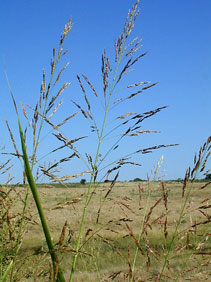JOHNSON GRASS
|
 |
| File Size: 96 KB |
|
|
|
Sorghum halepense (L. ) Pers.
|
| Mitchell County, Kansas |
| Perennial |
| Height: 2-7 feet |
| Family: Poaceae - Grass Family |
| Flowering Period: July, August, September,October |
|
| Culms: | | Erect, stout, simple or branched, pubescent at nodes, otherwise glabrous. | | Blades: | | Flat, 8 to 36 inches long, .5 to 1.5 inches wide, drooping, usually glabrous, often purple spotted, midrib prominent. | | Sheaths: | | Usually shorter than internodes, open. | | Ligules: | | Membranous, conspicuously fringed. | | Inflorescences: | | Panicles, open, oval to oblong in outline, 6 to 20 inches long, often purplish; branches whorled; axils hairy. | | Spikelets: | | In pairs; sessile spikelets fertile, 2-flowered, ovate-lanceolate, pale greenish yellow to purplish; awns to 1/2 inch long, twisted and bent; stalked spikelets usually staminate, narrower, lanceolate; awns absent. | | Habitat: | | Open waste areas, roadsides and field margins, in moist soil. | | Distribution: | | Throughout Kansas. | | Origin: | | Johnson grass is a native of the Mediterranean region and was introduced into the U.S. around 1830. | | Forage Value: | | Johnson grass has moderate forage value but is poisonous to livestock if grazed under drought conditions or following the first frost due to its prussic acid content. | | Uses: | | Kiowa children used the stems and leaves to make whistles. | | Comments: | | Rhizomatous. Johnson grass has been used for forage and to stop soil erosion, but it can become a troublesome weed. Its strong rhizomes make it difficult to eradicate. |
|
| Johnson grass |  | | 164 KB | | Konza Prairie, Riley County, Kansas |
| | Johnson grass leaf |  | | 79 KB | | Konza Prairie, Riley County, Kansas |
| | Johnson grass |  | | 160 KB | | Konza Prairie, Riley County, Kansas |
| | Johnson grass inflorescence |  | | 93 KB | | Konza Prairie, Riley County, Kansas |
| | Johnson grass habit |  | | 236 KB | | Tallgrass Prairie National Preserve, Chase County, Kansa |
| |
|
|
|
|
|
|